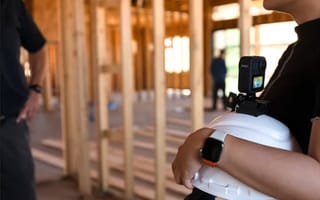Mosaic’s name isn’t an unrelated word slapped on an eye-catching logo — it’s an encapsulation of the many different components that bring the technical construction company’s image and purpose to life. And as employees of different backgrounds and experiences achieve unique goals, they unite the organization’s overall vision like various shimmering tiles cast in plaster to create a bigger picture.
Mosaic’s mission is to be the first elastic national general contracting service for digitally empowering the homebuilding industry. Departments like construction, technology, finance and design come together in order to push innovation and rethink what’s possible in the ever-evolving field of construction. However, teams at Mosaic have another unique mission requiring complex data analysis: to manage construction as code.
“A unique thing about Mosaic is that we’re a company that combines construction and technology fields — those two worlds and respective cultures could not be more different,” said Director of Data Science Jessica Steele. “But watching successful partnerships between the technology team, construction managers and other operations team members has been really powerful to witness.”
MULTIPLE COMPONENTS MAKE UP MOSAIC’S MISSION
When Steele initially joined Mosaic, she expected to utilize her background in data analytics and visualization to fulfill whatever demands her department experienced. However, leadership had a different vision for her abilities: Build out the company’s data science team to stand out from other competitors in the field. “The first question I asked was, ‘Are you sure?’” Steele recalled.
But the challenge paid off. Today in her role, Steele leads a team of data engineers and analysts to build and maintain the company’s data infrastructure, generate real-time reports and forecasts for both internal company teams and external stakeholders, and help build a data-driven culture within the company.
“Our data team is part of a larger technology team at our company, which creates tools and products that make our design and build construction services possible,” Steele said.
Now, the data science team collaborates closely with almost every department throughout the company in order to make a difference every day — viewing each new project as a partnership, focusing on business users’ underlying needs and challenges.
“We rely on our growth, strategic operations and product teams to share new project ideas, challenging us to come up with innovative and creative analytics solutions,” Steele said. “What most excites me is the role that data and technology can play in revolutionizing the industry.”

Why did Mosaic need to build out a data science team? What gave rise to it, and what impact will this team have on the business or its customers?
Mosaic decided to invest early in a data team to help set them apart from their competitors. In order to shake up the construction industry, we’re combining internal and external data sets to glean important insights about what’s most effective about our approach, as well as where we can improve.
We can also provide up-to-date insights and information to customers which will help them make informed decisions about their business. Longer term, we hope to contribute our learnings and data products to the larger field of construction in order to shift the paradigm of how companies are currently operating.
We work closely with our construction operations, finance and leadership teams to provide real-time reports and dashboards that help them monitor business performance and streamline project management efforts. We do our best to keep stakeholders informed of our progress on their respective projects and requests, making our data roadmap and other competing priorities as transparent as possible.
“Watching successful partnerships between the technology team, construction managers and other operations team members has been really powerful to witness.”
What role did you play in developing the data science team? What skills or assets were integral to launching the team?
My background is more in data analytics and visualization, and I certainly didn’t have direct experience creating a brand new data infrastructure. That said, I had previously worked closely with data engineering teams to transform and merge data across disparate systems, and I was enticed by the idea of getting to build both a team and architecture from the ground up.
My first hire was a senior level data engineer who helped guide the build a sophisticated data infrastructure that houses unstructured, semi-structured and structured data in a centralized repository, and where we can easily transform that data into “gold layer” tables that our business users and analysts can utilize. We’re using a cloud-based infrastructure in AWS, which allows us to be nimble and flexible as we continue to expand. We also use a business intelligence tool called Metabase as a final layer to serve as our company’s internal data platform, which makes it easy to implement self-service analytics across the company.
“We’re a company that is combining construction and technology fields — those two worlds and respective cultures could not be more different.”
What obstacles did you encounter along the way? How did you successfully overcome them?
By far the biggest challenge at the start was figuring out where we even begin. There are a myriad of different approaches to building a data infrastructure, and each has its respective pros and cons. We spent the first few months doing a deep dive exploration on what made most sense for our company, both in its current state, but also a solution we could effectively scale.
We’ve faced additional challenges along the way, such as merging data across different customers, legacy construction management systems and types of construction — horizontal, single family home with custom options, build to rent and so on — so that we could glean company-wide insights. We’ve been building our infrastructure and reporting in parallel with our products, which means that we’re often faced with data schema changes and building workaround solutions if a specific product feature is backlogged. Navigating shifting priorities as our company continues to expand has also been a challenge.
I’ve found that placing an emphasis on building strong relationships with company stakeholders, as well as prioritizing a strong team culture, has led to trust and patience among team members. I also try to always lead with the “why” so that team members understand the underlying decision-making that may shift their focus area. Finally, understanding their personal motivations and future career goals has helped me carve out opportunities that keep them engaged, challenged and inspired.









